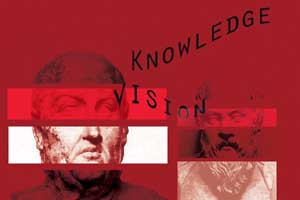Bartsch looks through eyes of classical thinkers
By Seth SandersNews Office
 |
People today say they understand things by seeing them; they gain insight by ‘seeing the point’ or ‘illuminating a topic’ and found knowledge on ‘objective observations.’ But, says Shadi Bartsch, Chair and Professor of Classical Languages & Literatures and the College, while the ancients shared this vocabulary, they may have had a radically different notion of what it meant to see something, and thus what it means to understand something.
Bartsch is working on a new book on the relationship between vision, love and knowledge in the classical world. What she has learned so far suggests that understanding the thinkers of the past requires seeing through their eyes in a literal and sometimes shocking way. The book reveals a world very different from ours “in which the laws of physics, vision and love share an intimate connection.”
Bartsch starts from the premise that ideas about philosophy and science-indeed, any meaningful knowledge of the world-are affected by how people talk about those ideas: that in fact, metaphors matter. But the Greeks and Romans, according to Bartsch, experienced vision as a kind of actual physical contact. Our philosophical ancestors saw vision as a tactile experience, in which the eyes sent out rays that touched the object, or the object emitted copies of itself that actually touched one’s eyes. No wonder the Greeks thought of learning and sexuality as connected, and the Romans thought sight was entangled in moral problems.
Bartsch realized she needed to ask completely different questions about what knowledge was for the ancients in order to relate their thought to contemporary thought. “It’s only when you ask questions whose assumptions are alien to our culture that you can find answers whose truths are alien to our culture. If the assumptions of the question are alien, the truths you find will be alien.” The questions have serious consequences. Bartsch cautions against “treating the visual language of philosophy as if it were independent of the culture that generated it.”
Bartsch began by asking why sight is privileged in philosophy today. She found first, that people think seeing does not affect the object that is viewed. Second, people think they can see limitlessly, to the horizon-like knowledge, there is no limit on the range of sight. And third, people believe it is instantaneous. The problem, she realized, was that for classical thinkers none of those things seemed to be true.
In Greece at that time, knowledge, sex and vision were linked in a positive way, but in Rome they were considered a dangerous combination. Trying to find facts about each society that varied as well as their attitudes toward seeing, she began to develop the theory that the difference was political.
For Socrates, the first step to self-knowledge was the establishment of a mutually admiring relationship between the philosopher-citizen and the freeborn adolescent male. This relationship, “both erotic and educational in nature, is incubated in the exchange of the gaze.” The beginning of any true knowledge involves mirroring the soul’s beauty in that of another-knowledge starts with a kind of love that happens when two men’s eyes touch.
Bartsch began to realize that Roman society, too, was dependent on mutual monitoring. The elites watched each other in a game of mutual surveillance to perpetuate their standards of behavior. The whole society was like a show, as senators displayed their names on buildings and coins. But when the emperor took over this stage, replacing the senators’ names and images with his own, that public arena for virtue disappeared.
Philosophers and politicians worried that the outward gaze, so important for the moral preservation of the elite, was vanishing. Seneca, both a philosopher and a politician, tried to replace this vanished gaze with an inward eye-a person should imagine how it would feel to be seen by everyone-a first step toward a conscience by pretending to act for some imaginary other.
And here an element of perversion comes in, raising deep questions about this conscience. First, if the audience is imaginary, how steady is the moral imperative that comes from it? And what if seeing the bad is enjoyed? If the mirror is a metaphor for the self, bad citizens such as Hostius Quadra looked in the mirror and liked the wicked things they saw. Hostius staged orgies in front of distorted mirrors and said, “I know all this is a lie, but I like what I see.” Bartsch said Hostius turned a mirror on philosophy, showing that self-reflection might produce nothing but superficial self-satisfaction.
“The reason I like to ask these questions,” said Bartsch, “is that it brings home how much historical and social truths are dependent on the context in which they arise. I really don’t think there’s any such thing as a truth out of context, which you could take as relativistic or you could take as a sensitivity to the way truths that seem self-evident to us can be so different in other cultures, as to make apparently familiar truths require reconsideration.”
It is by taking a closer look into some surprising, if disturbing, truths that Bartsch is able to advance beyond old questions of absolute truth vs. relativism. A new view of the metaphors on which knowledge is grounded leads to a self-understanding, which goes deeper than a mirror’s surface.
![[Chronicle]](/images/sidebar_header_oct06.gif)